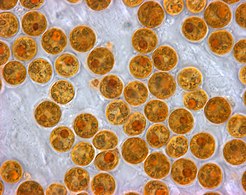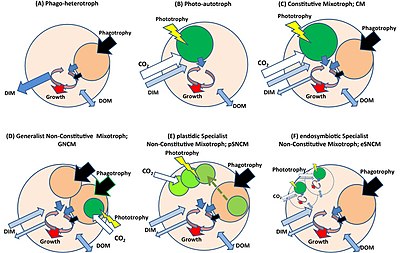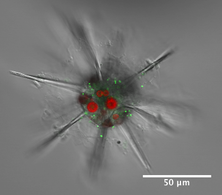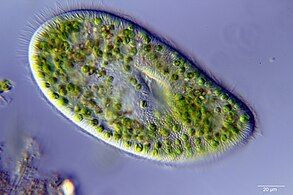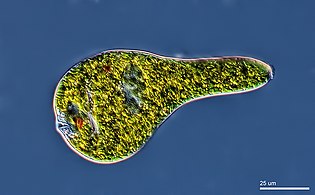Mixotroph
A mixotroph is an organism that can use a mix of different
Possible combinations are photo- and chemotrophy, litho- and organotrophy (osmotrophy, phagotrophy and myzocytosis), auto- and heterotrophy or other combinations of these. Mixotrophs can be either eukaryotic or prokaryotic.[3] They can take advantage of different environmental conditions.[4]
If a trophic mode is obligate, then it is always necessary for sustaining growth and maintenance; if facultative, it can be used as a supplemental source.
Overview
Organisms may employ mixotrophy obligately or facultatively.
- Obligate mixotrophy: To support growth and maintenance, an organism must utilize both heterotrophic and autotrophic means.
- Obligate autotrophy with facultative heterotrophy: Autotrophy alone is sufficient for growth and maintenance, but heterotrophy may be used as a supplementary strategy when autotrophic energy is not enough, for example, when light intensity is low.
- Facultative autotrophy with obligate heterotrophy: Heterotrophy is sufficient for growth and maintenance, but autotrophy may be used to supplement, for example, when prey availability is very low.
- Facultative mixotrophy: Maintenance and growth may be obtained by heterotrophic or autotrophic means alone, and mixotrophy is used only when necessary.[5]
Plants

Amongst plants, mixotrophy classically applies to carnivorous, hemi-parasitic and myco-heterotrophic species. However, this characterisation as mixotrophic could be extended to a higher number of clades as research demonstrates that organic forms of nitrogen and phosphorus — such as DNA, proteins, amino-acids or carbohydrates — are also part of the nutrient supplies of a number of plant species.[6]
Animals
Mixotrophy is less common among animals than among plants and microbes, but there are many examples of mixotrophic invertebrates and at least one example of a mixotrophic vertebrate.
- The spotted salamander, symbiotic algae living inside them,[7] the only known example of vertebrate cells hosting an endosymbiont microbe (unless mitochondria is considered).[8][9]
- freshwater or marine invertebrate or protozoan.
- Reef-building corals (Scleractinia), like many other cnidarians (e.g. jellyfish, anemones), host endosymbiotic microalgae within their cells, thus making them mixotrophs.
- The Oriental hornet, Vespa orientalis, can obtain energy from sunlight absorbed by its cuticle.[11] It thus contrasts with the other animals listed here, which are mixotrophic with the help of endosymbionts.
-
Zooxanthellae is a photosynthetic algae that lives inside hosts like coral
-
Anthopleura xanthogrammica gains its green colour from Zoochlorella
-
Thezooxanthella, a unicellular organism capable of photosynthesis.[12]
Microorganisms
Bacteria and archaea
Protists

DIN = dissolved inorganic nutrients
To characterize the sub-domains within mixotrophy, several very similar categorization schemes have been suggested. Consider the example of a marine protist with heterotrophic and photosynthetic capabilities: In the breakdown put forward by Jones,[19] there are four mixotrophic groups based on relative roles of phagotrophy and phototrophy.
- A: Heterotrophy (phagotrophy) is the norm, and phototrophy is only used when prey concentrations are limiting.
- B: Phototrophy is the dominant strategy, and phagotrophy is employed as a supplement when light is limiting.
- C: Phototrophy results in substances for both growth and ingestion, phagotrophy is employed when light is limiting.
- D: Phototrophy is most common nutrition type, phagotrophy only used during prolonged dark periods, when light is extremely limiting.
An alternative scheme by Stoeker[18] also takes into account the role of nutrients and growth factors, and includes mixotrophs that have a photosynthetic symbiont or who retain chloroplasts from their prey. This scheme characterizes mixotrophs by their efficiency.
- Type 1: "Ideal mixotrophs" that use prey and sunlight equally well
- Type 2: Supplement phototrophic activity with food consumption
- Type 3: Primarily heterotrophic, use phototrophic activity during times of very low prey abundance.[21]
Another scheme, proposed by Mitra et al., specifically classifies marine planktonic mixotrophs so that mixotrophy can be included in ecosystem modeling.[20] This scheme classified organisms as:
- Constitutive mixtotrophs (CMs): phagotrophic organisms that are inherently able to also photosynthesize
- Non-constitutive mixotrophs (NCMs): phagotrophic organisms that must ingest prey to attain the ability to photosynthesize. NCMs are further broken down into:
- Specific non-constitutive mixotrophs (SNCMs), which only gain the ability to photosynthesize from a specific prey item (either by retaining plastids only in kleptoplastidy or by retaining whole prey cells in endosymbiosis)
- General non-constitutive mixotrophs (GNCM), which can gain the ability to photosynthesize from a variety of prey items
(A) phagotrophic (no phototrophy); (B) phototrophic (no phagotrophy); (C) constitutive mixotroph, with innate capacity for phototrophy; (D) generalist non-constitutive mixotroph acquiring photosystems from different phototrophic prey; (E) specialist non-constitutive mixotroph acquiring plastids from a specific prey type; (F) specialist non-constitutive mixotroph acquiring photosystems from endosymbionts. DIM = dissolved inorganic material (ammonium, phosphate etc.). DOM =
-
Acantharian radiolarian hosts Phaeocystissymbionts
-
White Phaeocystis algal foam washing up on a beach
-
A single-celledendosymbiotically
-
Euglena mutabilis, a photosynthetic flagellate
-
Euglenoid
-
Fluorescent micrograph of anacantharian with Phaeocystissymbionts fluorescing red (chlorophyll)
See also
Notes
- ^ Beware the mixotrophs - they can destroy entire ecosystems 'in a matter of hours'
- ^ [S. G. Leles et al, Oceanic protists with different forms of acquired phototrophy display contrasting biogeographies and abundance, Proceedings of the Royal Society B: Biological Sciences (2017).]
- ^ PMID 17028233.
- S2CID 22837754.
- ^ Schoonhoven, Erwin (January 19, 2000). "Ecophysiology of Mixotrophs" (PDF). Thesis.
- PMID 32481119.
- ISSN 0028-0836.
- ^ Frazer, Jennifer (May 18, 2018). "Algae Living inside Salamanders Aren't Happy about the Situation". Scientific American Blog Network.
- PMID 28462779.
- JSTOR 1224630.
- S2CID 14022197.)
{{cite journal}}: CS1 maint: multiple names: authors list (link - S2CID 208553146.
- ISBN 978-0-7637-5345-0.
- ISBN 978-0-387-25492-0.
- ISBN 978-3-13-108411-8.
- PMID 12813068.
- ^ Friedrich, Cornelius G.; et al. (2007). "Redox Control of Chemotrophic Sulfur Oxidation of Paracoccus pantotrophus". Microbial Sulfur Metabolism. Springer. pp. 139–150.[permanent dead link] PDF[dead link]
- ^ .
- ^ .
- ^ PMID 26927496..
 Material was copied from this source, which is available under a Creative Commons Attribution 4.0 International License
Material was copied from this source, which is available under a Creative Commons Attribution 4.0 International License - ^ Tarangkoon, Woraporn (29 April 2010). "Mixtrophic Protists among Marine Ciliates and Dinoflagellates: Distribution, Physiology and Ecology" (PDF). Thesis.[permanent dead link]
External links
- Troost TA, Kooi BW, Kooijman SA (February 2005). "When do mixotrophs specialize? Adaptive dynamics theory applied to a dynamic energy budget model". Math Biosci. 193 (2): 159–82. PMID 15748728.
- Sanders, Robert W. Mixotrophic Nutrition of Phytoplankton: Venus Fly Traps of the microbial world Archived 2011-08-05 at the Wayback Machine. Temple University.

